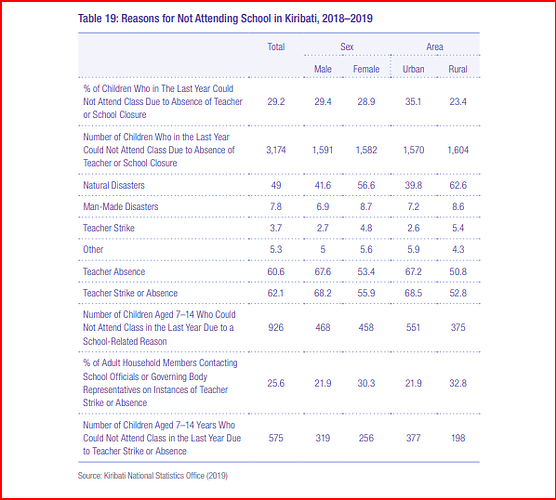- The number stays high, especially in secondary school. Many students leave school after primary or junior secondary.
- More boys drop out in primary school, but more girls drop out in secondary school, often due to family duties or early pregnancy.
- Families can’t afford school costs, students on outer island find it hard to access school, cultural reasons like early marriage or helping at home
- The government is giving frees education and building more junior secondary schools in outer islands. They also run awareness programs to support girls and reduce early dropouts.
Q1: What is the trend in terms of number of children out of school from year to year in Fiji?
The number of children out of school in Fiji has generally been declining over recent years. Government initiatives, especially the introduction of free education and transport assistance, have contributed significantly to reducing dropout rates and increasing school enrolment.
Q2: What is the trend of out-of-primary-school children by gender?
Out-of-school rates tend to be slightly higher for boys than girls at the primary level. However, the gender gap is not very wide, suggesting relatively balanced access, although challenges remain for both genders, especially in rural and maritime regions.
Q3: List three main causes of school drop-out in Fiji.
- Poverty and financial constraints, including inability to afford school-related costs (uniforms, meals, etc.) despite free tuition.
- Geographic isolation, particularly in rural and outer island communities where transportation is limited.
- Social and family issues, such as early pregnancy, family responsibilities, or lack of parental support.
Q4: Post in the discussion forum measures your government is taking to get out-of-school children and youth to participate in education.
The Fijian Government has implemented several key measures to address the issue of out-of-school children. These include the provision of free primary and secondary education, transport assistance schemes (such as subsidised bus fares), and the introduction of inclusive education policies targeting students with disabilities. Furthermore, community outreach programmes aim to raise awareness among parents about the importance of continuous education. These initiatives are crucial in improving enrolment, especially in rural and disadvantaged communities.
Why mainstream ODL- Activity 1
Q1: What is the trend in terms of number of children out of school from year to year in Fiji?
The number of out-of-school children in Fiji shows a declining trend over the years. Consistent government efforts and increased investment in the education sector have helped bring more children into classrooms and keep them enrolled through primary and secondary levels.
Q2: What is the trend of out-of-primary-school children by gender?
Gender disparities in out-of-school rates are minor in Fiji. Girls and boys generally have similar chances of attending school, though boys are slightly more at risk of leaving school early, especially in remote areas where they are often involved in labor or family responsibilities.
Q3: List three main causes of school drop-out in Fiji.
- Economic hardship – Families may still struggle with indirect costs like meals, uniforms, or stationery.
- Cultural or family expectations – Especially in rural areas, children may be expected to support household or farming duties.
- School distance and accessibility – Lack of nearby schools or reliable transport discourages attendance, especially in maritime zones.
Q4: Post in the discussion forum measures your government is taking to get out-of-school children and youth to participate in education.
Concise Policy-Oriented Response
To reduce the number of out-of-school children, the Fijian Government has adopted strategies such as free education at all levels, school transport subsidies, and flexible learning pathways including vocational programs. Policies also support inclusive education for learners with disabilities and second-chance education programs for dropouts.
Narrative Community-Focused Response
The government in Fiji is helping more kids stay in school by making education free and supporting families with things like bus fares. They’re also offering skills training and vocational paths for those who don’t fit into the regular system. It’s good to see efforts made to reach children in villages and outer islands, so no one is left behind.
Bula From Fiji,
-
Trend in out-of-school children:
Out-of-school numbers have decreased overall but remain a concern in low-income and remote areas where education is less accessible. -
Gender trend in primary education:
More boys than girls drop out of primary school, often due to early labor or disengagement from formal learning. -
Three main causes of school drop-out:
* Household poverty
* Transport difficulties in rural/island areas
* Early marriage or caregiving roles (especially girls) -
Government measures:
As a Home Economics teacher, I support how the Fijian government uses TV and radio lessons, promotes skills-based learning, and supports inclusive education through vocational tracks. These help bring out-of-school youth back into learning using real-life, practical skills.
